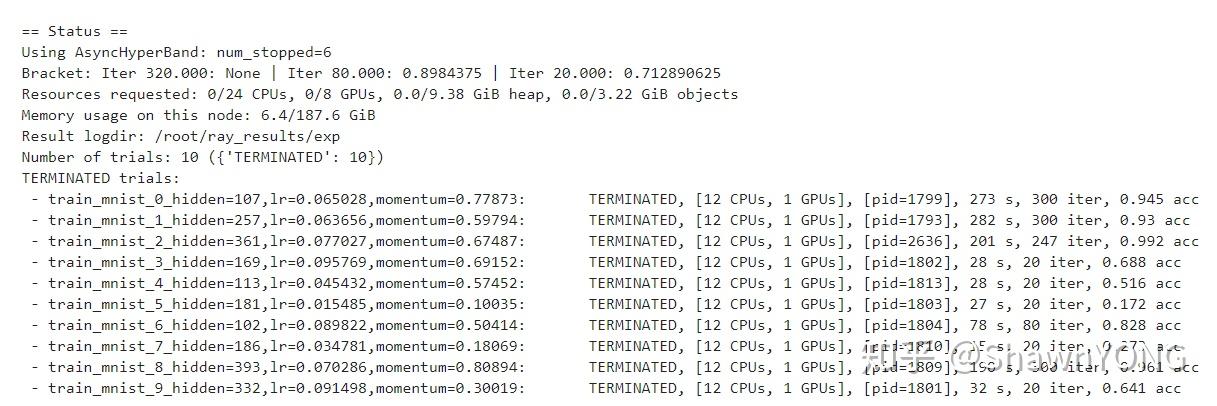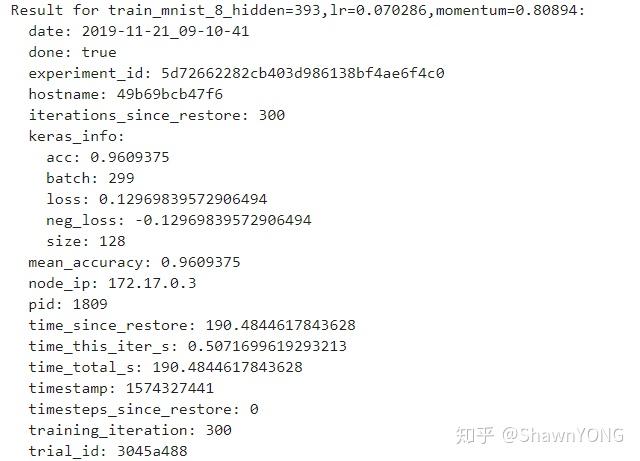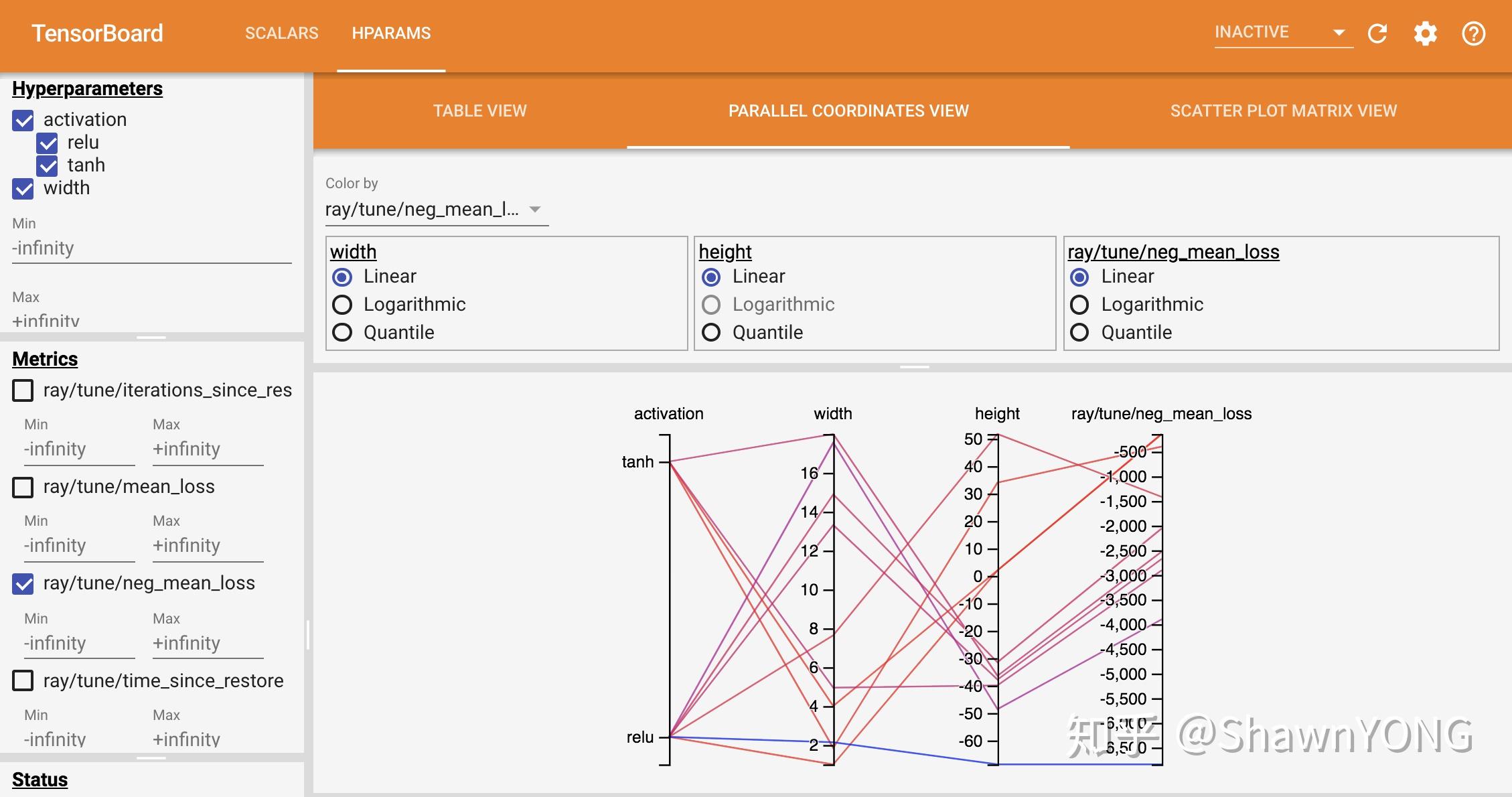超参优化工具总结(4)——Ray.tune
Homepage:https://github.com/ray-project/ray/tree/master/python/ray/tune
特性:集成了多种超参优化方法,运行在Ray分布式计算框架上,拓展性强。Ray是一种高度集成的Automl框架,内容较多,我们在此只总结其结合超参优化的部分——Ray.tune
Tune 结构总览

Tune可接受用户定义的Python function或class,并根据从超参空间中取出的一组超参配置(hyperparameter configurations)对其进行评估;每组超参配置(hyperparameter configurations)组成的评估可称为一次Trail,并且Tune支持多个Trails并行运行。其中配置(configuration)可以从Tune中生成,也可以从用户指定的搜索算法中获得。而Trail由Schedulers进行安排和管理。
使用特色:
- 用不到10行代码即可完成多节点分布式超参数搜索
- 支持所有现有机器学习框架(framework),包括PyTorch, XGBoost, MXNet, 和Keras等
- 使用TensorBoard可视化结果。
- 能选择任何可扩展的先进算法,例如Population Based Training(PBT), Vizier’s Median Stopping Rule, HyperBand/ASHA。
使用方法及配置
使用方法:
https://ray.readthedocs.io/en/latest/tune.html
基于pytoch利用small grid search 优化CNN的示例
import torch.optim as optim
from ray import tune
from ray.tune.examples.mnist_pytorch import get_data_loaders, ConvNet, train, test
#定义训练模型及优化器,搜索空间
def train_mnist(config):
train_loader, test_loader = get_data_loaders()
model = ConvNet()
optimizer = optim.SGD(model.parameters(), lr=config["lr"])
for i in range(10):
train(model, optimizer, train_loader)
acc = test(model, test_loader)
tune.track.log(mean_accuracy=acc)
#调用ray.tune进行优化
analysis = tune.run(
train_mnist, config={"lr": tune.grid_search([0.001, 0.01, 0.1])})
#输出结果
print("Best config: ", analysis.get_best_config(metric="mean_accuracy"))
#获取分析实验结果的dataframe
df = analysis.dataframe()
#利用tensoboard进行分析
tensorboard --logdir ~/ray_results支持系统:macOS + linux
是否支持GPU:是
优化库基于:
- ray
- 所有现有机器学习框架(framework),包括PyTorch, XGBoost, MXNet, 和Keras等
优化算法
- 先进算法,如Hyperband(最低限度地训练模型来确定超参数的影响)
- AsyncHyperBand
- 基于群体的训练算法(Population Based Training,在共享超参数下同时训练和优化一系列网络)
- Nevergrad()
- 贝叶斯优化算法和Ax(AX 是PyTorch中贝叶斯优化的一个平台)
- Hyperopt方法搜索(Tree-structured Parzen Estimators)和中值停止规则(如果模型性能低于中等性能则停止训练)
- Grid Search and Random Search(only uses the default search space and variant generation process 其他都需单独定义)
- BayesOpt
- Scikit-Optimize
- BOHB(Bayesian Optimization HyperBand)
适用范围:Deep Learning, Reinforcement Learning
分布式计算:Ray分布式计算框架(ray.remote执行远程进程操作)
分布式计算
cluster_name: local-default
provider:
type: local
head_ip: YOUR_HEAD_NODE_HOSTNAME
worker_ips: [WORKER_NODE_1_HOSTNAME, WORKER_NODE_2_HOSTNAME, ... ]
auth: {ssh_user: YOUR_USERNAME, ssh_private_key: ~/.ssh/id_rsa}
## Typically for local clusters, min_workers == max_workers.
min_workers: 3
max_workers: 3
setup_commands: # Set up each node.
- pip install ray torch torchvision tabulate tensorboardcluster_name: tune-default
provider: {type: aws, region: us-west-2}
auth: {ssh_user: ubuntu}
min_workers: 3
max_workers: 3
# Deep Learning AMI (Ubuntu) Version 21.0
head_node: {InstanceType: c5.xlarge, ImageId: ami-0b294f219d14e6a82}
worker_nodes: {InstanceType: c5.xlarge, ImageId: ami-0b294f219d14e6a82}
setup_commands: # Set up each node.
- pip install ray torch torchvision tabulate tensorboard"搜索空间定义
hyperparameter_space = {
""lr"": tune.loguniform(0.001, 0.1),
""dense_1"": tune.uniform(2, 128),
""dense_2"": tune.uniform(2, 128),
}(tensorflow) //定义超参和它的搜索空间
def generate_hyperparameters():
return {
""learning_rate"": 10**np.random.uniform(-5, 1),
""batch_size"": np.random.randint(1, 100),
""momentum"": np.random.uniform(0, 1)
}(torch)
"
输出示例
1.直接输出结果
以基于Keras对Mnist的优化结果为例:
超参空间为:
config={
"threads": 2,
"lr": tune.sample_from(lambda spec: np.random.uniform(0.001, 0.1)),
"momentum": tune.sample_from(
lambda spec: np.random.uniform(0.1, 0.9)),
"hidden": tune.sample_from(
lambda spec: np.random.randint(32, 512)),
})10个Trails,使用24GPUs,8GPUs的环境,每个Trail指定3CPUs+1GPUs,同时可以并行训练6个Trails。结果如下:

训练结果中可看出第3个Trail准确率最高,为0.992,其中Result放入路径:Result logdir: /root/ray_results/exp中,后续可用Tensorboard读取分析。
而每个Trail具体结果也进行输出:(以第八个一个Trail为例)

以基于Torch对Mnist的优化结果为例:
3个Trails,超参空间为:
config={"lr": tune.grid_search([0.001, 0.01, 0.1])})

2.分析结果:
输出结果可用Tensorboard读取,包括训练时每个trial用到的不同超参,以及每个trail loss随时间变化
输出~/ray_results/tune_iris(example)
可用tensorboard读取
Ray中GPU使用方法
https://ray.readthedocs.io/en/latest/using-ray-with-gpus.html#gpu-support
1.Ray对GPU的基本调用方法
通过Ray.init(),Ray会自动初始化并检测可用GPU的数量,即tensorflow会自动检测gpu并进行调用(通常会检测所有可用资源,包括CPU,Memory等);同时,也可以通过ray.init(num_gpus=N) or ray start --num-gpus=N指定(也可通过num_cpus、memory、object_store_memory等对整个程序可调用的cpu数量,内存等进行限制),类似于CUDA_VISIBLE_DEVICES
如:本身有机器性能为:12 CPUs,12 GPUs
Ray.init()后,该程序总共可支配12 CPUs,12 GPUs
Ray.init(num_cpus=6,num_gpus=3)后,该程序可总共可支配6 CPUs,3 GPUs
Ray.init(num_cpus=15,num_gpus=3)后,该程序运行错误,因为超出可支配范围
2.指定每个Trail中GPU等资源使用情况(基于Tensorflow和keras)示例程序
通过给tune.run()传入参数resources_per_trial={}来指定每个Trial所占用的资源如下:
tune.run(
num_samples=10,
resources_per_trial={
"cpu": 3,
"gpu": 1,
},
)其中num_samples指的是从搜索空间中采样的数量,即Trial的总数量;在机器仍具备可获资源进行Trial时,会并行进行多个Trail,如按以上设定,总可用12GPUs,12CPUs,那么会最多同时并行4个Trail,其余Trail在队列中等待。
3.Ray远程调用GPU(未成功复现,缺少相应远程调用环境)
Ray使远程功能可以在ray.remote() 装饰器中指定其GPU要求:@ray.remote(num_gpus=1)
在远程函数内部,对的调用ray.get_gpu_ids()将返回一个整数列表,指示允许远程函数使用哪些GPU。通常,不需要调用ray.get_gpu_ids()因为Ray会自动设置CUDA_VISIBLE_DEVICES环境变量。实际使用时Ray只能保留GPU,通过TensorFlow的GPU版本来调用GPU
基于ray.remote()分割GPU的例子:
import ray
import time
ray.init(num_cpus=4, num_gpus=1)
@ray.remote(num_gpus=0.25)
def f():
time.sleep(1)
# The four tasks created here can execute concurrently.
ray.get([f.remote() for _ in range(4)])原理是在多个任务共享一个GPU时,通过人为的限制,让每个任务所占用的GPU memory不超过所设比例;并且TensorFlow可以通过设定来限制其GPU Memory使用率

